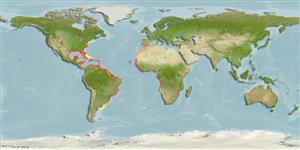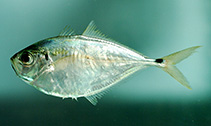Chloroscombrus chrysurus (Linnaeus, 1766)
Atlantic bumper
把你的觀察加入 Fish Watcher
| Native range | All suitable habitat | Point map | Year 2050 |

|
| This map was computer-generated and has not yet been reviewed. |
| Chloroscombrus chrysurus AquaMaps Data sources: GBIF OBIS |
Brazil country information
Common names:
Arriba saia, Caico, Caracaxá
Occurrence: native
Salinity: brackish
Abundance: | Ref:
Importance: | Ref:
Aquaculture: | Ref:
Regulations: | Ref:
Uses: no uses
Comments: Ranges from Bahia south to Santa Catarina (Ref. 57756). Also Ref. 7251, 55758.
National Checklist:
Country Information: https://www.cia.gov/library/publications/resources/the-world-factbook/geos/br.html
National Fisheries Authority:
Occurrences: Occurrences Point map
Main Ref: Floeter, S.R., J.L. Gasparini, L.A. Rocha, C.E.L. Ferreira, C.A. Rangel and B.M. Feitoza, 2003
National Database:
Occurrence: native
Salinity: brackish
Abundance: | Ref:
Importance: | Ref:
Aquaculture: | Ref:
Regulations: | Ref:
Uses: no uses
Comments: Ranges from Bahia south to Santa Catarina (Ref. 57756). Also Ref. 7251, 55758.
National Checklist:
Country Information: https://www.cia.gov/library/publications/resources/the-world-factbook/geos/br.html
National Fisheries Authority:
Occurrences: Occurrences Point map
Main Ref: Floeter, S.R., J.L. Gasparini, L.A. Rocha, C.E.L. Ferreira, C.A. Rangel and B.M. Feitoza, 2003
National Database:
Common names from other countries
分類 / Names 俗名 | 同種異名 | Catalog of Fishes(屬, 種) | ITIS | CoL | WoRMS | Cloffa
Teleostei > Carangiformes (Jacks) 鱸形目 (Jacks) > Carangidae (Jacks and pompanos) 鰺科 (Jacks and pompanos) > Caranginae
Etymology: Chloroscombrus: Greek, chloros = green + Greek, skombros = the name of several fishes, a mackerel (Ref. 45335).
More on author: Linnaeus.
Etymology: Chloroscombrus: Greek, chloros = green + Greek, skombros = the name of several fishes, a mackerel (Ref. 45335).
More on author: Linnaeus.
Environment: milieu / climate zone / depth range / distribution range 生態學
海洋; 半鹹淡水; 深度上下限 0 - 110 m (Ref. 114025). 亞熱帶的; 42°N - 41°S, 98°W - 14°E
分布 國家 | FAO區域 | 生態系 | 發現紀錄 | Point map | 簡介 | Faunafri
Western Atlantic: Massachusetts to Florida, USA and Bermuda to Uruguay; throughout Caribbean Sea and Gulf of Mexico (Ref. 9626); Bahamas, Antilles, along Central and South American coasts to Uruguay (Ref. 26938). Eastern Atlantic: Spain to Angola (Ref. 57392). First recorded from the Mediterranean Sea (Ref. 128468).
Replaced by Chloroscombrus orqueta in eastern Pacific. These two species have not been adequately studied and may prove to be conspecific.
西大西洋: 麻薩諸塞州到美國的佛羅里達與百慕達群島到烏拉圭; 在加勒比海與墨西哥灣各處;(參考文獻 9626) 巴哈馬 , 安地列斯群島, 沿著中央的與南美洲岸邊到烏拉圭.(參考文獻 26938) 東大西洋: 茅利塔尼亞到安哥拉。 在東太平洋中被 Chloroscombrus orqueta 取代了。 這兩個種沒有足夠地被研究而且可能證明是同種的。
西大西洋: 麻薩諸塞州到美國的佛羅里達與百慕達群島到烏拉圭; 在加勒比海與墨西哥灣各處;(參考文獻 9626) 巴哈馬 , 安地列斯群島, 沿著中央的與南美洲岸邊到烏拉圭.(參考文獻 26938) 東大西洋: 茅利塔尼亞到安哥拉。 在東太平洋中被 Chloroscombrus orqueta 取代了。 這兩個種沒有足夠地被研究而且可能證明是同種的。
Length at first maturity / 大小 / 重量 / 年齡
Maturity: Lm 12.4, range 10 - ? cm
Max length : 65.0 cm TL 雄魚/尚未辨別雌雄; (Ref. 57392); common length : 25.0 cm TL 雄魚/尚未辨別雌雄; (Ref. 5217); 最大體重: 121.00 g (Ref. 128468)
Max length : 65.0 cm TL 雄魚/尚未辨別雌雄; (Ref. 57392); common length : 25.0 cm TL 雄魚/尚未辨別雌雄; (Ref. 5217); 最大體重: 121.00 g (Ref. 128468)
簡短描述 檢索表 | 型態特徵 | 形態測量圖
背棘 (總數) : 9; 背的軟條 (總數) : 25 - 28; 臀棘: 3; 臀鰭軟條: 25 - 28. Diagnosis: body compressed and deep (depth comprised from 2.3 to 2.8 times in fork length) (Ref. 57392), its ventral profile distinctly more convex than the dorsal (Ref. 26938, 57392). Snout very short, its tip blunt, upper jaw extending almost to behind level of anterior eye margin; 2 dorsal fins, the first with 8 spines, the second with 1 spine and 25-28 soft rays; anal fin with 2 detached spines, followed by 1 spine and 25-28 soft rays; upper lobe of caudal fin longer than the lower; small, cycloid scales covering most of body, including chest; 5-15 weak scutes on posterior part of lateral line, at level of caudal peduncle, the latter without bilateral keels (Ref. 57392). Metallic blue above, silvery below; caudal peduncle with black saddle spot (Ref. 3197).
Coloration: back greenish or bluish, sides silvery-white; a dark, saddle-shaped blotch on caudal peduncle just before caudal fin, and another at upper angle of gill cover (Ref. 57392).
鐵藍色的上方, 下面銀色的; 尾梗有黑色的斑點。 (參考文獻 3197) 低的輪廓更多的強烈彎曲超過上面的。 (參考文獻 26938).
鐵藍色的上方, 下面銀色的; 尾梗有黑色的斑點。 (參考文獻 3197) 低的輪廓更多的強烈彎曲超過上面的。 (參考文獻 26938).
Adults are found over soft bottoms of the continental shelf; sometimes forming schools near the surface (Ref. 5217). Marine pelagic species very common in coastal lagoons and estuaries (Ref. 57392). They feed on fish, cephalopods, zooplankton and detritus (Ref. 28587). Juveniles common in brackish estuaries and often associated with jellyfish (Ref. 5217). Marketed fresh and salted.
發現在大陸棚的軟質底部上了; 有時形成群體接近水表面。 (參考文獻 5217) 吃魚,頭足類動物,浮游動物與碎屑。 (參考文獻 28587) 稚魚常見於半鹹淡的河口 (參考文獻 5217) 與時常伴隨著水母。 在市場上銷售生鮮地了與鹽醃的。
發現在大陸棚的軟質底部上了; 有時形成群體接近水表面。 (參考文獻 5217) 吃魚,頭足類動物,浮游動物與碎屑。 (參考文獻 28587) 稚魚常見於半鹹淡的河口 (參考文獻 5217) 與時常伴隨著水母。 在市場上銷售生鮮地了與鹽醃的。
Life cycle and mating behavior 成熟度 | 繁殖 | 產卵場 | 卵 | 孕卵數 | 仔魚
西大西洋: 麻薩諸塞州到美國的佛羅里達與百慕達群島到烏拉圭; 在加勒比海與墨西哥灣各處;(參考文獻 9626) 巴哈馬 , 安地列斯群島, 沿著中央的與南美洲岸邊到烏拉圭.(參考文獻 26938) 東大西洋: 茅利塔尼亞到安哥拉。 在東太平洋中被 Chloroscombrus orqueta 取代了。 這兩個種沒有足夠地被研究而且可能證明是同種的。
主要參考資料
Upload your references | 參考文獻 | 合作者 : Smith-Vaniz, William F. | 合作者
Smith-Vaniz, W.F., J.-C. Quéro and M. Desoutter, 1990. Carangidae. p. 729-755. In J.C. Quero, J.C. Hureau, C. Karrer, A. Post and L. Saldanha (eds.) Check-list of the fishes of the eastern tropical Atlantic (CLOFETA). JNICT, Lisbon; SEI, Paris; and UNESCO, Paris. Vol. 2. (Ref. 7097)
對人類具威脅
無害處的
人類使用
漁業: 商業性
FAO(漁業: 產生; publication : search) | FishSource | 周邊海洋
更多資訊
Population dynamics
成長參數
Max. ages / sizes
Length-weight rel.
Length-length rel.
長度-頻率
Mass conversion
入添量
豐度
成長參數
Max. ages / sizes
Length-weight rel.
Length-length rel.
長度-頻率
Mass conversion
入添量
豐度
Anatomy
鰓區
Brain
Otolith
鰓區
Brain
Otolith
Physiology
Body composition
Nutrients
耗氧量
游泳類型
游泳速度
Visual pigments
Fish sound
Diseases & Parasites
Toxicity (LC50s)
Body composition
Nutrients
耗氧量
游泳類型
游泳速度
Visual pigments
Fish sound
Diseases & Parasites
Toxicity (LC50s)
工具
E-book | 野外調查 | 檢索表 | 長度- 頻率 Wizard | 生活- 歷史的工具 | 分布圖 | Classification Tree
| Catch-MSY |
特別的報告
下載 XML
網路資源
Aquatic Commons | BHL | Cloffa | Websites from users | 檢查 FishWatcher | CISTI | Catalog of Fishes(屬, 種) | DiscoverLife | ECOTOX | Faunafri | Fishtrace | GenBank(基因組, 核甘) | GloBI | GOBASE | GoMexSI (interaction data) | | Google Books | Google Scholar | Google | IGFA World Record | MitoFish | 國家資料庫 | Otolith Atlas of Taiwan Fishes | PubMed | Reef Life Survey | Scirus | SeaLifeBase | 樹狀分類階層 | Wikipedia(去, 搜尋) | World Records Freshwater Fishing | 動物學的記錄
Estimates based on models
Preferred temperature (Ref. 115969): 23.2 - 28, mean 26.2 (based on 552 cells).
Phylogenetic diversity index (Ref. 82804): PD50 = 0.7500 [Uniqueness, from 0.5 = low to 2.0 = high].
Bayesian length-weight: a=0.01230 (0.01090 - 0.01389), b=2.94 (2.91 - 2.97), in cm Total Length, based on LWR estimates for this species (Ref. 93245).
營養階層 (Ref. 69278): 3.5 ±0.2 se; based on diet studies.
回復力 (Ref. 120179): 中等的, 族群倍增時間最少 1.4 - 4.4年 (K=0.22-0.56).
Prior r = 0.57, 95% CL = 0.37 - 0.85, Based on 3 data-limited stock assessments.
Fishing Vulnerability (Ref. 59153): Low to moderate vulnerability (29 of 100).
Climate Vulnerability (Ref. 125649): High to very high vulnerability (75 of 100).




